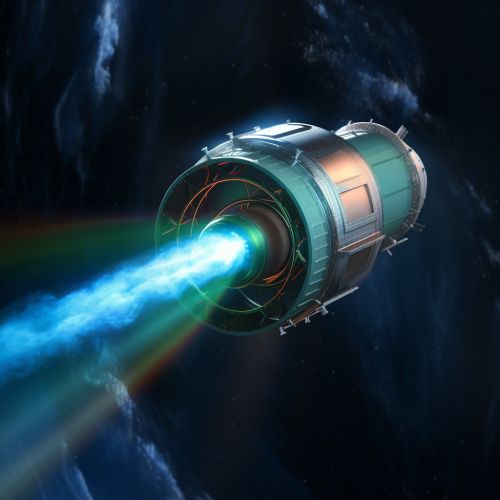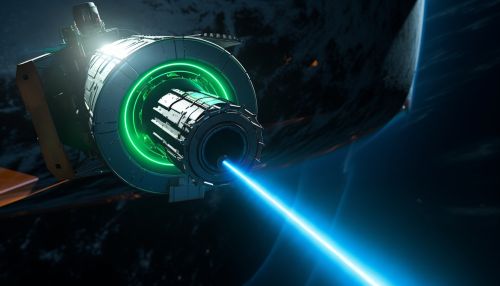Electric Propulsion
Introduction
Electric propulsion is a class of propulsion technology involving the use of electric power to accelerate a propellant by different possible electrical and/or magnetic means. The most common types of electric propulsion systems are ion thrusters, Hall effect thrusters, and electrodeless plasma thrusters. This technology is primarily used in spacecraft propulsion and has been deployed for station keeping, attitude control, in-space propulsion, and potential future applications such as interplanetary missions.


Principles of Operation
Electric propulsion systems function on the principle of Newton's third law of motion: "For every action, there is an equal and opposite reaction." In the case of electric propulsion, the action is the ejection of propellant (ions) from the spacecraft, and the reaction is the force exerted on the spacecraft in the opposite direction. The propellant is ionized and accelerated by electric fields, which can be generated by a variety of means.
Ionization
The first step in electric propulsion is the ionization of the propellant. This involves stripping electrons from the propellant atoms to create positively charged ions. This process can be achieved through several methods, including electron bombardment, radio frequency (RF) ionization, and microwave ionization.
Acceleration
Once the propellant is ionized, it can be accelerated by electric and/or magnetic fields. This acceleration imparts a high velocity to the ions, which are then expelled from the spacecraft, providing thrust. The specific method of acceleration varies depending on the type of electric propulsion system used.
Types of Electric Propulsion Systems
There are several types of electric propulsion systems, each with its own advantages and disadvantages. The choice of system depends on the specific requirements of the mission, such as the required thrust, power availability, and mission duration.
Ion Thrusters
Ion thrusters use electrostatic forces to accelerate ions. The ions are generated by ionizing a neutral gas, usually xenon, and are then accelerated by an electric field. Ion thrusters are capable of very high exhaust velocities, which makes them highly efficient in terms of propellant usage. However, they produce relatively low thrust, which makes them unsuitable for missions requiring high acceleration.
Hall Effect Thrusters
Hall effect thrusters operate on a similar principle to ion thrusters, but use magnetic fields to trap electrons, which then ionize the propellant. This results in a higher ionization efficiency and allows for the use of a wider range of propellants. Hall effect thrusters are capable of higher thrust than ion thrusters, but at the cost of slightly lower exhaust velocity.
Electrodeless Plasma Thrusters
Electrodeless plasma thrusters use radio frequency or microwave energy to ionize the propellant, which is then accelerated by magnetic fields. These systems have the advantage of not requiring electrodes, which can erode over time, limiting the lifespan of other types of electric propulsion systems.
Applications
Electric propulsion systems are primarily used in space, where their high efficiency and long operational lifetimes make them ideal for many applications. These include station keeping, attitude control, and in-space propulsion for missions such as satellite repositioning, orbit raising, and interplanetary exploration.
Station Keeping
Electric propulsion systems are commonly used for station keeping, which involves maintaining a spacecraft's position and orientation in orbit. This requires small but precise amounts of thrust, which electric propulsion systems are well-suited to provide.
Attitude Control
Electric propulsion can also be used for attitude control, which involves adjusting the orientation of a spacecraft. This is typically done using small thrusters that provide precise amounts of thrust.
In-Space Propulsion
For missions requiring significant changes in velocity, such as satellite repositioning or orbit raising, electric propulsion systems can be an efficient choice. Their high exhaust velocities allow for a greater change in velocity for a given amount of propellant compared to chemical propulsion systems.
Interplanetary Missions
Electric propulsion systems are being considered for future interplanetary missions due to their high efficiency and long operational lifetimes. These missions require significant amounts of thrust over long periods of time, which electric propulsion systems are capable of providing.
Future Developments
Research is ongoing into new types of electric propulsion systems and improvements to existing technologies. This includes work on systems with higher thrust and efficiency, as well as the development of new propellants and power sources. Electric propulsion is a rapidly evolving field, and future advancements have the potential to significantly enhance our capabilities for space exploration.
